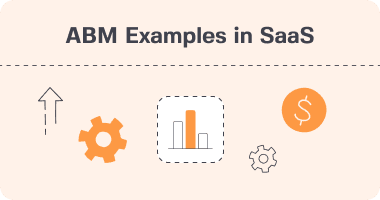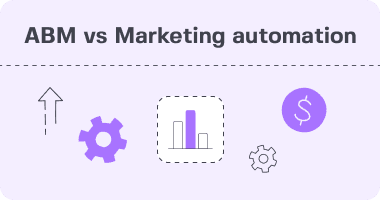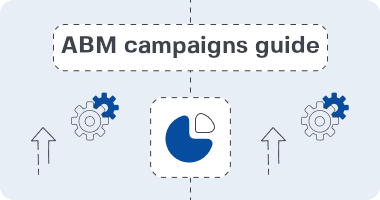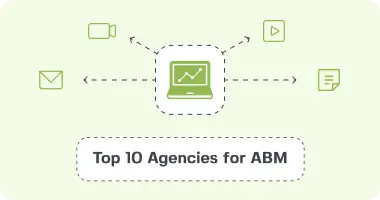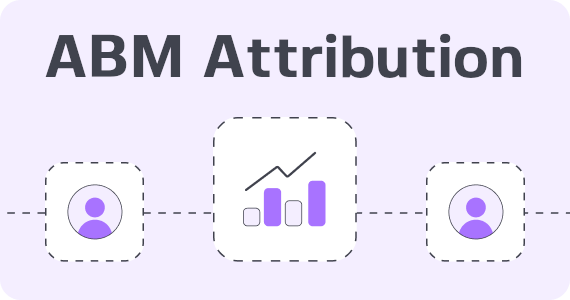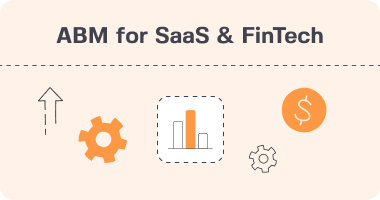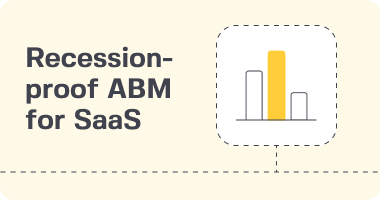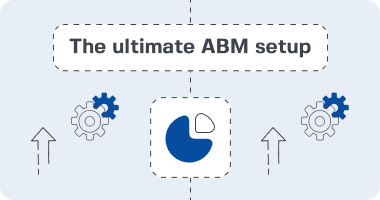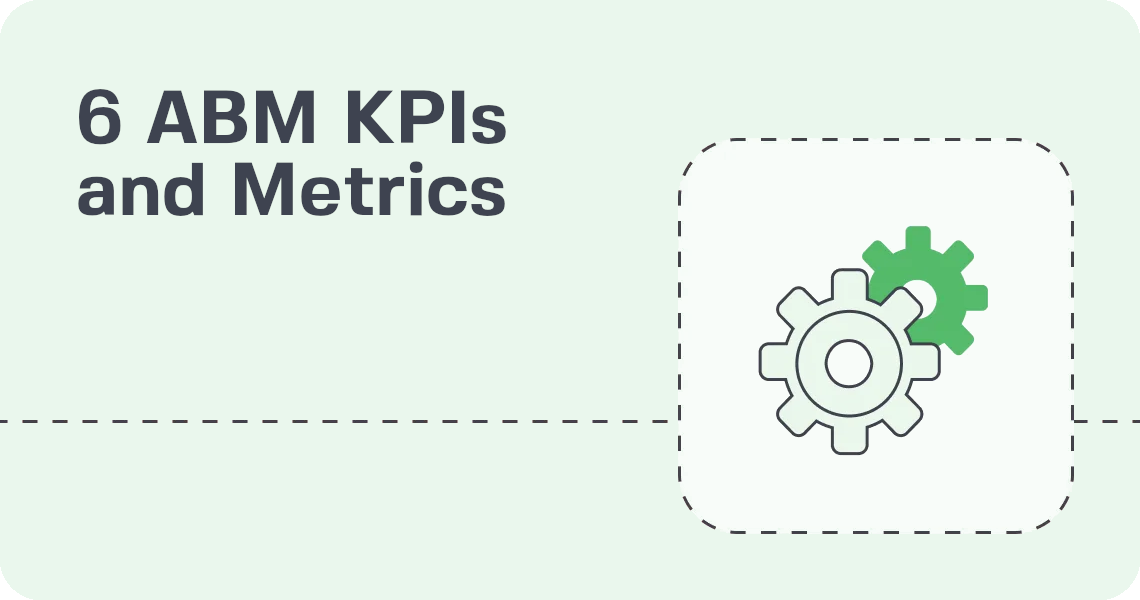For mid-sized and enterprise B2B tech companies with long sales cycles, complex buying committees, and resource-strapped marketing teams, an account-based marketing (ABM) plan is no longer optional — it’s a revenue strategy. Account-based marketing requires the marketing and sales teams to collaborate on a shared strategy. A sales aligned approach is essential for ABM success, ensuring both teams work together to maximize impact.
An effective ABM plan enables you to:
- Focus on high-value accounts that deliver the highest ROI
- Align sales and marketing around shared targets
- Personalize engagement across channels at scale
- Measure revenue impact with clear attribution
- Build a well-defined go to market plan that aligns teams and effectively targets high-value accounts
If your current challenges sound like this:
“We have dozens of target accounts but no clear engagement strategy”
“Sales and marketing aren’t working from the same list”
“We’re spending on campaigns without seeing pipeline impact”
… then you need a structured ABM plan that drives measurable results and business growth by focusing on high-value opportunities.
Step 1: Define Your ABM Goals and KPIs
Before picking tools or tactics, clarify what your ABM program should achieve. Setting clear KPIs is essential for running successful campaigns and accurately measuring the impact of your ABM efforts. For enterprise B2B tech, common goals include:
- Increasing win rates for top-tier accounts
- Reducing sales cycle length
- Expanding existing account revenue
- Improving sales and marketing alignment
KPIs to track:
- Target account engagement rate
- Opportunities created per account tier
- Pipeline value generated vs. influenced
- Revenue generated from target accounts
- Multi-touch attribution results
Step 2: Build Your Ideal Customer Profile (ICP)
Your ABM plan starts with knowing exactly who you’re targeting.
An ICP defines the firmographic, technographic, and behavioral traits of your best-fit accounts. Using account qualification criteria is crucial to identify accounts that fit your ICP and ensure your marketing and sales teams are aligned. Identifying target accounts is essential for implementing account-based marketing strategies.
Data points to include:
- Industry & sub-industry
- Company size & revenue
- Tech stack compatibility
- Buying signals (recent funding, hiring trends, RFP activity)
- Leverage industry reports to inform your ICP and target companies
Using account specific data can further refine your target list and help personalize your outreach.
Pro tip for lean teams: Use intent data from platforms like 6sense or Bombora to prioritize accounts already showing purchase signals.
Step 3: Segment and Tier Your Target Accounts
Not all accounts deserve the same level of investment. Use a tiered approach to balance personalization with scale:
- Tier 1: Focus on key accounts and high value account opportunities with high-touch, fully customized plays (1:1 ABM)
- Tier 2: Industry-specific personalization (1:few ABM)
- Tier 3: Programmatic personalization using automation (1:many ABM)
Why it matters for enterprise B2B: This approach ensures resources go to the accounts most likely to deliver big wins, while still engaging broader market segments.

Step 4: Align Sales and Marketing Around Shared Targets
ABM fails without alignment. For ABM success, the sales team and marketing departments must align marketing and sales efforts to ensure unified strategies, effective collaboration, and streamlined workflows.
- A single source of truth for target account lists (CRM or ABM platform)
- Jointly owned account playbooks where sales teams work closely with marketing to develop and execute agreed outreach cadences
- Regular pipeline review meetings to adjust tactics in real time
Tools to help:
- Salesforce + Marketing Cloud for unified CRM and automation
- HubSpot Enterprise for smaller teams needing fast alignment
- Outreach.io for coordinated sales engagement
Step 5: Choose the Right ABM Channels and Tactics
Selecting the right marketing tactics is crucial for ABM success. Enterprise ABM requires multi-channel orchestration to reach buying committees:
High-Impact Channels for ABM in 2025:
- Account-based email marketing – Personalized sequences triggered by buying signals
- LinkedIn ads – Highly targeted campaigns to decision-maker job titles
- Ad campaigns – Personalized and account-specific ad campaigns across platforms to engage high-value accounts
- Programmatic display – Personalized creative based on industry and buyer stage
- Executive webinars – Invite-only sessions for C-level stakeholders
- Social media platforms (e.g., LinkedIn, Twitter) – Targeted engagement and relationship building with key accounts
- Direct mail & gifting – High-touch for Tier 1 accounts
Social selling is an effective tactic for engaging target accounts on social media platforms, building authentic relationships, and complementing other marketing channels.
Certain tactics, such as webinars and targeted ads, can also support lead generation for high-value accounts.
Pro tip: Use ABM orchestration tools like Demandbase One or Terminus to manage targeting, creative, and reporting across all channels.
Step 6: Create Personalized Content at Scale
Personalization is the heart of any ABM plan.
For lean enterprise teams, this means modular content creation. Personalization in ABM can involve creating custom content, messaging, and offers tailored to specific accounts’ needs. Addressing each account’s pain points and specific pain points is crucial—content should speak directly to the challenges and needs of each ABM account. Crafting a compelling value proposition for each account ensures your messaging resonates and demonstrates the unique benefits you offer.
- Core message stays consistent
- Elements like case studies, data points, and CTAs adapt by account or industry
Content formats to prioritize:
- ROI calculators specific to the account’s industry
- Personalized landing pages with ABM tools like Mutiny
- Case studies matched to the target’s vertical
- Customer journey mapping to visualize and address customer relationships throughout the ABM process
Essential ABM Software and Tools for 2025
Selecting the right ABM software and tools is foundational to executing a successful account-based marketing strategy in 2025. Today’s leading ABM platforms empower marketing and sales teams to work in lockstep, targeting high-value accounts with precision and efficiency. Tools like Demandbase, RollWorks, and HubSpot offer robust features for account engagement, personalized messaging, and campaign automation, enabling your teams to create personalized content at scale and track key metrics such as customer lifetime value.
Modern ABM software streamlines the process of identifying and prioritizing target high-value accounts, automating sales efforts, and delivering relevant content to each decision-maker. With advanced analytics, marketing and sales can measure the impact of their ABM campaigns in real time, optimizing strategies for maximum ROI. By leveraging these platforms, your marketing strategy becomes more data-driven, your sales teams more effective, and your account-based marketing efforts more measurable and scalable than ever before.
Building Your ABM Team: Roles and Collaboration
A high-performing ABM program is built on strong collaboration between sales and marketing teams. Success starts with assembling a cross-functional team that includes account managers, marketing teams, and sales teams—all working together to identify target accounts, create personalized content, and execute coordinated ABM campaigns.
Clear roles and responsibilities are essential: account managers oversee high-value accounts and ensure personalized outreach, while marketing teams develop targeted messaging and content tailored to each account’s needs. Sales teams focus on building relationships and driving sales efforts that align with marketing initiatives. When sales and marketing are on the same page, your ABM campaigns are more likely to resonate with target high-value accounts, resulting in increased engagement, more qualified opportunities, and accelerated revenue growth.
Step 7: Measure, Optimize, and Scale
An ABM plan isn’t “set and forget.” Use real-time analytics to refine targeting, messaging, and spend allocation. Proactively measuring ABM success is essential for course correction and optimizing strategies in response to performance data.
Metrics to monitor:
- Engagement by account and buying stage
- Conversion from engagement to pipeline
- Win rate improvements for targeted accounts
- Revenue influenced by ABM campaigns
- Customer retention rates
- Number of qualified leads generated from ABM efforts
Optimization loop:
- Review engagement data monthly
- Reallocate budget to best-performing channels
- Test new personalization tactics
- Expand to new accounts as capacity allows
- Review and optimize ABM efforts based on performance data
Ensuring ABM Sustainability for Long-Term Success
Long-term success with ABM requires more than a one-time campaign—it demands ongoing commitment from both sales and marketing teams. Sustainable ABM strategies involve continuous investment in abm software, regular training for marketing teams, and a culture of collaboration across all sales and marketing efforts.

Emerging ABM Trends Shaping 2025
The ABM landscape in 2025 is being transformed by several key trends. Artificial intelligence (AI) and machine learning (ML) are now central to personalizing ABM messaging and content, allowing businesses to deliver highly relevant experiences to each target account. Advanced account-based analytics are also gaining traction, enabling marketing and sales teams to measure the effectiveness of their ABM campaigns and make data-driven decisions that fuel revenue growth.
Another major trend is the heightened focus on customer experience and retention. Companies are investing in strategies that create personalized, value-driven interactions for their most important accounts, recognizing that a successful ABM strategy is not just about acquisition but also about nurturing long-term relationships. By embracing these trends, organizations can ensure their strategy remains competitive, impactful, and aligned with the evolving expectations of their target accounts.
The ABM Ecosystem: Integrating Partners and Platforms
A robust ABM ecosystem brings together various partners and platforms to support account-based marketing efforts. By integrating marketing automation platforms, CRM systems, data analytics tools, and other technologies, businesses can streamline the process of targeting high-value accounts and delivering personalized content at every stage of the customer journey. Building a well-integrated account-based marketing framework lays the foundation for scalable, effective, and future-proof ABM.
Common Pitfalls to Avoid
- Targeting too many accounts at once
- Lack of dedicated ABM ownership
- Over-reliance on a single channel
- No integration between ABM tools and CRM
- Inconsistent follow-up from sales
- Relying on traditional marketing approaches that lack personalization and targeted engagement
- Failing to integrate ABM with other marketing strategies, such as inbound marketing, for a holistic and effective outreach
Making Your ABM Plan a Revenue Driver
In 2025, an ABM plan is not just a marketing play — it’s a revenue strategy that aligns teams, focuses on high-value opportunities, and delivers measurable business impact.
For B2B tech enterprises, the most successful ABM plans are:
- Data-driven — using intent signals and ICP insights
- Integrated — with CRM, martech, and sales workflows
- Personalized — delivering value to each decision-maker
- Measurable — tied directly to revenue metrics
With the right structure, tools, and alignment, your ABM plan becomes your business’s engine of predictable growth.
Stop guessing. Start closing.
Your high-value accounts won’t wait — and neither should you.


